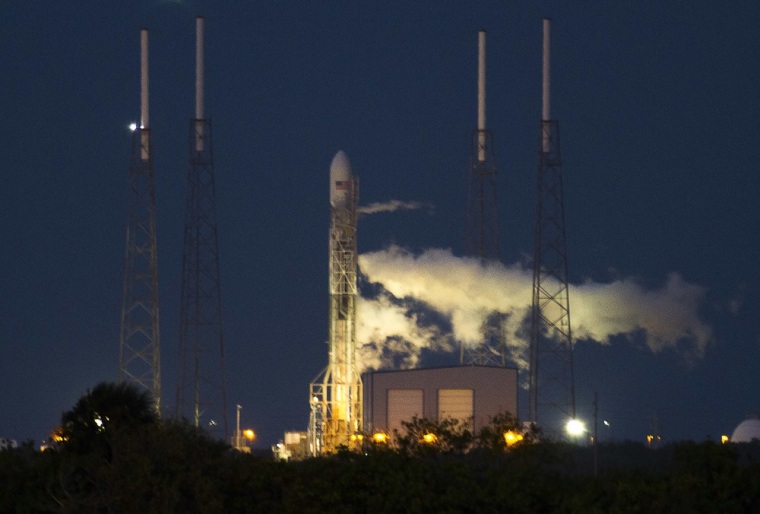The launch of an unmanned SpaceX Falcon 9 rocket was aborted before liftoff on Thursday due to a technical issue, company officials said.
It was the second attempt this week to launch a communications satellite for SES, which operates the world's second largest fleet.
Monday's first attempt was called off after unusual pressure readings in the rocket's liquid oxygen tank. On Thursday, the clock ticked all the way down to ignition of the Falcon's nine first-stage engines — but the flight computer immediately shut down the engines. "Launch aborted by autosequence due to slower than expected thrust ramp," SpaceX's billionaire founder, Elon Musk, reported in a Twitter update.
The countdown was restarted but then stopped again with less than a minute left because engineers had not finished analyzing the data from the earlier glitch. "Better to be paranoid and wrong," Musk explained. He said it would take a few days to inspect the engines and reschedule the next launch attempt.
'Extremely important' satellite
Perched on top of the rocket at Cape Canaveral Air Force Station in Florida was a 7,000-pound (3,175-kilogram) telecommunications satellite owned by Luxembourg-based SES, which operates a 54-satellite telecom fleet, the world's second-largest.
The satellite, known as SES-8 and worth about $100 million, will be positioned to provide television, cable, broadband and other services to customers in India, China, Vietnam and other markets in Asia.
"It's an extremely important satellite for us," Martin Halliwell, chief technology officer of SES, told reporters at a prelaunch gathering on Sunday in Cocoa Beach, Fla. "We know that as we go forward into these very significant growth markets that it's absolutely critical that we have a cost-effective and efficient way to get to orbit. That's really what SpaceX has brought us."
Previous SES satellites were launched primarily aboard Russian Proton and European Ariane rockets, which cost far more than the approximately $55 million the company paid for its ride on SpaceX's Falcon booster, Halliwell said. He would not say exactly how much SpaceX undercut the competition, but he did say SES got a discount by agreeing to fly on Falcon 9's first mission to the high altitude that communications satellites require.
Upgraded Falcon
In addition to a Sept. 29 test flight of an upgraded Falcon 9, older versions of the rocket have flown successfully five times, including three missions for NASA to deliver cargo to the International Space Station, which orbits about 250 miles (400 kilometers) above Earth.
SpaceX aims to put SES-8 into an elliptical orbit that reaches more than 50,000 miles from Earth, about a quarter of the way to the moon. That altitude requires less fuel for SES-8 to fly itself into its 22,369-mile-high (36,000-kilometer-high) operational orbit, thereby extending its service life.
SpaceX hoped to demonstrate its ability to fire up the Falcon 9's upper-stage engine twice during the September test flight, but that did not work. Engineers later realized that liquid oxygen, used for chilling, had come into contact with the motor's igniter lines, causing them to freeze.
"It was not a complicated issue to fix. Obviously, we were glad we caught it on a mission where we were only demonstrating that second burn, as opposed to one where we have to get it done," SpaceX President Gwynne Shotwell told reporters during a prelaunch conference call.
Placing bets
The company needs three successful launches of its upgraded Falcon rocket before it will be eligible to compete to carry the U.S. military's largest and most expensive satellites, a market now monopolized by United Launch Alliance, a partnership of Boeing and Lockheed Martin.
"There's always some risk associated with the flight not working. So we're very appreciative that SES would place a bet on SpaceX," Musk said earlier this week.
SES has options for three more Falcon flights, including one on the firm's heavy-lift rocket, which is under development and expected to make its debut next year.
SpaceX's launch manifest includes nearly 50 other launches, worth about $4 billion. About 75 percent of the flights are for commercial customers.
"Our prices are the most competitive of any in the world," Musk said. "We will force other rocket companies to either develop new technology that's a lot better or they have to exit the launch market."
Halliwell said SpaceX competitors were "shaking in their shoes."
"There are a lot of people who hope that SpaceX is going to fail," he said. "This is really rocking the industry."
The global satellite industry had revenues of nearly $190 billion in 2012, including nearly $90 billion in television services alone, the Satellite Industry Association trade group reported in October. The U.S. share of the market is 45 percent, the report said.
This report was updated by NBC News.
